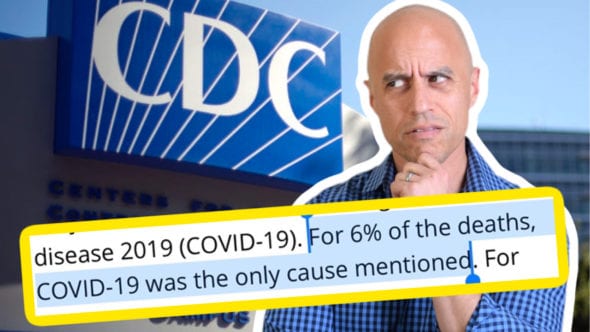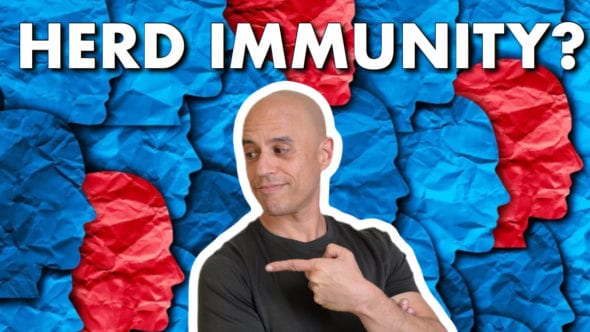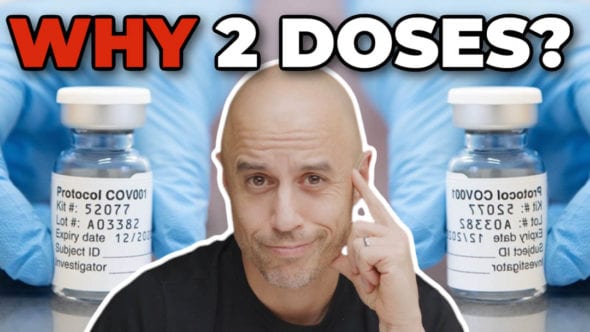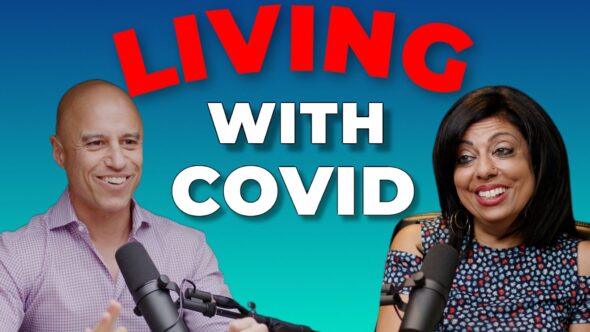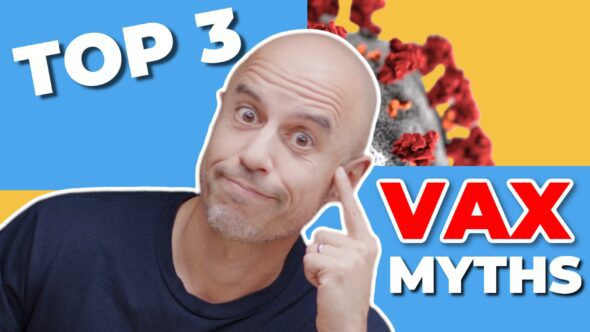Here’s what the results so far actually MEAN.
The press release. And here’s a great schematic of how this vaccine works.
Full Transcript Below.
Hey everybody, really big news that the press is of course not doing justice to, we have a single dose, single vaccination administration, coronavirus vaccine now that has pretty good efficacy no matter what articles you’re reading right now in the news and it’s Johnson and Johnson’s new coronavirus vaccine that’s been studied recently. So let’s talk about this. I wanna unpack kind of what the news has been saying about this and actually give you what’s really going on. Because this is actually a remarkable development in a series of remarkable developments around coronavirus vaccines.
I mean, I think vaccine science has been advanced by an order of magnitude since the pandemic because, we have the ability to do large randomized controlled trials on tons of people with a high degree of prevalence of the infection you’re trying to prevent that has a series of outcomes that you can measure. And we’re doing it with vaccine candidates that are using technologies that have not historically been approved for vaccines, but have been studied for a long long time. Let’s talk about Johnson and Johnson. So we’ve been talking about this vaccine as a potential thing for quite some time, because the magic of it is unlike the other vaccine regimens so far proposed, this is a single shot.
So instead of the three weeks apart that Pfizer’s vaccine is or the four weeks apart that Moderna’s is, or roughly that period apart that the AstraZeneca or the Novavax are, this is a single dose. And the way that it works is different than these other candidates to this degree. So instead of a fat particle, lipid nanoparticle encasing a piece of messenger RNA, which is the code, the little email that tells a cell how to make the spike protein, that’s a component of the virus that you want to generate an immune response to in the form of antibodies and B and T cell sort of memory response. Instead of doing it in the lipid nanoparticle and synthesizing that mRNA, the way that Johnson and Johnson Vaccine works is it takes a human cold virus, so an adenovirus, and it takes that virus and it weakens it, so that virus can no longer replicate.
It normally infects humans and causes typically the common cold type symptoms, but they’ve basically wrecked its ability to actually replicate in human cells. So it can’t make you sick. Then it’s replaced its normal genetic code that it would need to replicate and make more adenovirus, it replaced it with, I believe a double-stranded DNA version of that RNA that the normal coronavirus would use to take over cells, it takes a tiny piece of it that codes just for the spike protein that we talked about and tells your cell so that little piece of code enters cells so the adenovirus merges with the cell membrane in the cells of your arm where you’re injecting the vaccine, it then delivers this piece of DNA, so it’s not RNA it’s DNA, and it gets into the nucleus gets transcribed into protein, sorry, into messenger RNA at that point then goes back into the cytoplasm of the cell and it’s turned into the spike protein, which is then pushed to the surface of the cell shown to the immune system and the rest is history. And we’ve talked about that process for the other vaccines, so I won’t get into all that.
So it’s a slightly different approach, right? So remember we were saying like, mRNA doesn’t get into the nucleus because it doesn’t belong there, but DNA does and then it uses the normal nuclear machinery to actually make RNA and then a protein in the cytoplasm. So it works, you can make spike protein this way without making the human host sick because the adenovirus itself doesn’t replicate. So you make, take a bunch of adenovirus, injected in the arm, those infect the cells once, the DNA enters and gets transcribed and translated into protein, the protein then goes to the surface and you make an immune response. So that’s the theory and the practice of how the vaccine works. Now the question is, does it work? So the other vaccines showed maximum immunogenicity meaning they develop a stronger immune response after two doses, one dose wasn’t enough. And in fact, after one dose with those mRNA vaccines, you don’t generate as strong a response as being naturally infected with coronavirus, that’s not good.
You want ideally your response to be the same or better than natural infection, because we’re not even sure natural infection immunity lasts more than a few months. So we really want a strong response especially for better efficacy. So this will do that with a single dose but then how does it show up in the trial? So, we don’t have all the trial data. What we have is what Johnson and Johnson released as their press release, as their sort of preliminary data. Remember with Pfizer and Moderna, they did the same thing. They’re like here’s some kind of basic premise and then when it gets submitted to the FDA for the Emergency Use Authorization application, that’s when the full trial data emerges and the FDA and the public can pour over every last line of the study. So, we have that sort of prelim right now and this is what we’re seeing.
Now what the press is reporting is 66% efficacy of this one shot vaccine. And they’re spinning it as, oh, no, such a promise and disappointment and doom and gloom. And please click on this headline that says, we’re all doomed and this vaccine is not nearly as good as the Pfizer and the Moderna, and please click on this and then watch the ads associated with it. And, but don’t bother with the nuance or actually what’s really going on. So the minute I saw the press reports on it, I’m like, okay, yeah well, we know what’s actually going on here, let’s look at the actual data that was released and then form an impression of that and then consult experts to see if you’re right. So I formed my impression, then I called Paul Offit and he concurred with what my impression was which is amazing when that happens, cause more often than not, he’s like, ah, no, you’re wrong, this is what’s actually going on. So here’s what’s happening. It was a big big trial, like tens of thousands of people, all right?
In three major regions, United States in North America, South America and South Africa. Now this is important, why South Africa? Because South Africa 95% of the patients that got infected in that trial with coronavirus got infected with the South African variant that has emerged that there has been increasing concern, oh, is this thing going to be safe, is it gonna work and be efficacious against this new variant? And the question is really a valid one because the variant has mutations in the spike protein particularly in and near the receptor binding domain which is where the sort of business end of the antibodies tend to neutralize the virus. And so if you make enough mutation in those areas you could theoretically escape vaccine.
Now there’s been no evidence that vaccine escape has occurred, there’s just been evidence in the lab with the mRNA vaccines, Moderna and Pfizer, that there’s reduced efficacy in the lab. It hadn’t been shown in the wild yet with the mRNA vaccines. Well, so here’s a trial where they actually use South Africa as one of the testing grounds. Novavax did this as well. They’re a purified protein adjuvanted vaccine, which we’ll talk about another show, I did it for Supporters already so they’re in the loop, but I’m actually much more interested in the Johnson and Johnson Vaccine. Why? Because it’s one dose. It’s and there’s other advantages which we’re gonna talk about. It’s a big deal you guys, like it’s really good news. Really, really good news.
All right, so listen to me here. They looked at these three regions and they said, okay what’s going on with moderate to severe disease at 14 days after the injection and 28 days after the injection. So these two end points, right? And then they followed out to about 49 days or so as what they reported so far. And this is what they found, in the United States the vaccine was 72% effective at preventing moderate to severe disease. So that means that basically the majority, right? Of the actual disease occurred in the placebo group, the group that got the saline injection instead of the actual vaccine. Now 72%, you’re just going, aw, moderate and severe disease, so we’re not really looking at asymptomatic disease. Neither did the, really the Moderna and the Pfizer try, Moderna looked a little bit at asymptomatic, but the main end point there was symptomatic disease.
They didn’t really talk about as much the same criteria they’re using here, so they’re saying moderate, severe. So, moderate is you have at least two systemic symptoms of the thing, or you’re having shortness of breath and your oxygen sat still above 93, there’s a series of criteria for moderate. Severe is you’re in ICU or you’re getting hospitalized or you have, you know, severe systematic symptoms of this. So that’s how they’re looking at it here and people are like, oh, no, well then, you know 72% doesn’t sound that good when Pfizer and these guys are talking about 95, 94% after two shots a week to two weeks after the second shot is when they’re measuring and they’re finding that degree of efficacy. So people are like, wait so back up a second and go, wait now… So after 14 days after one shot or 28 days, is when they when they actually measure these numbers, so at 28 days, 72% efficacy for moderate-severe disease. So we’re not just talking about like, you got a symptom or two, it’s moderate or severe disease.
So that’s already interesting in the US. In Latin America it was 66%, okay? So it’s different population, different variants floating around? Maybe some slight difference in how they did the trial, different comorbidities, we don’t know, right? Because we haven’t seen the primary data yet. But what happened in South Africa? 57% efficacy. 95% of the South Africans in that trial who were infected were infected with this B1.351, I believe it is, don’t quote me on that, them numbers get confusing, variant that has been felt to be potentially resistant. It’s certainly resistant to monoclonal antibodies that have been made, it’s resistant to convalescent sera that people have made antibodies to previous infections.
So it certainly has some wiliness about it this particular variant, and yet still 57% efficacious. So not zero, not vaccine escape, still above the 50% threshold. And actually when you look at the Novavax trial, which was a different vaccine when you exclude people with HIV, their numbers went up. So actually in that trial it was 50% efficacious in the South African group and 60% when you exclude people who are HIV infected. Now, that’s the other interesting thing about this trial. They included people with immune suppression, HIV, et cetera. 2.8% of the trial population had HIV, and they still had these really impressive numbers. Overall, I mean, it’s really remarkable.
So it’s still efficacious now, but here’s the part that just makes you go, this is awesome, across every single group that was studied, so the South Africans, the Americans, the Latinx, I don’t know if that’s a thing but I saw it on CNN once, 85% efficacy against preventing hospitalization and death. The two end points you most care about across, including in that, you know, mutation variant in South Africa, 85%. What is the main reason you wanna vaccinate as many people as possible? To prevent hospitalization and death, because that is what is causing the drama. Yeah, you might have other problems like long-haul COVID and other side effects of COVID that can happen from just being infected even with a mildly symptomatic case, but really where the rubber hits the road is when you’re talking about hospitalization and this vaccine in a single dose can drop 85%, I mean, that’s a huge deal.
And it tells you too, that all this, you know media hysteria over variants, it’s crucial to study the variants and to keep updating the vaccines and to make sure they work and to do surveillance and to get as many people immune as possible and reduce the spread, so you don’t generate so much viral replication that you’re generating new variants. That’s all true, but this sky is falling, nothing’s gonna work. This vaccine is only 66% efficacious on average across three areas with an 85% efficacy against hospitalization and death? Like now here it gets better. After the 28 days when they measured the efficacy continued to improve. So by 49 days, there were zero serious hospitalization or death in the vaccine group. All of it was in the placebo group.
So I don’t know what the press is doing but this is really really remarkably good news. Why? This vaccine, if you make a billion doses, which is doable, you vaccinate a billion people. If you make a billion doses of the Pfizer, Moderna vaccine you vaccinate half a million or 500 million people, and that’s assuming that they’re gonna come back, be compliant, get the second dose. If you don’t do both doses in those vaccines you have less efficacy, potentially more viral replication and more potential for escape, vaccine escape meaning you allow the thing to replicate, it’s gonna select for variants that evade the vaccine immunity and you’re in a worse shape if you don’t get both vaccines as a public health issue. So this one is a huge addition. Second thing that’s great about it is it’s stable at minus four degrees Fahrenheit, that’s just a little below freezing, that’s a freezer.
And it’s stable for like two years at that temperature and it’s stable for three months at like, you know, 36 to 44 degrees Fahrenheit which is standard refrigerator temperature. So pop it in the fridge. Think about the developing world. And it’s transportable with standard cold chain technology, you don’t need like this super-cold chain technology that the Pfizer Vax needs. That’s a huge deal especially when you’re talking about rural America, small clinics they don’t have these fancy freezers, line up outside a Walmart and get a ton of these or the developing world. I mean, what do you really care about in the developing world, hospitalization and death, right? Otherwise you develop natural herd immunity from the infection assuming you’re not causing collateral damage in terms of blood clots and long-haul COVID and things like that, right?
That we don’t fully understand yet. It’s a big deal. The other advantage of it is probably gonna be less expensive. And so the next step for the thing is they’re applying for EUA, probably February it’s gonna be reviewed. They’re already manufacturing the doses because it’s again it’s part of the Warp Speed thing, so, you know, the financial risk of manufacturing it, even if it doesn’t work is tiny tiny, cause the government did their part for once. They did it correctly as a public private partnership which was Warp Speed, which was really well done. And now we have this new tool in our armamentarium. Now we need to see the full data, we need to look at actually, oh, safety, safety. We care about safety, I think. Here’s the safety signal. It looks like there were about 9% of patients who got a fever from the vaccine and 0.2% of those were like high fever.
Otherwise there was no significant safety abnormality, no anaphylaxis in the trials and the placebo group had a higher reported incidents of adverse experiences than the vaccine group. So, so far the safety signal shows really good in tens of thousands of people across multiple continents. Even it gets better, it sounds like an infomercial. And again, I have no stake in any of these vaccines. I already got the Moderna vaccine, right? But here’s the deal. It gets better because they studied it across a bunch of different races, men and women, some autoimmune and immune compromised patients, all ages, and what they found was the efficacy held up in the separate age brackets. So it wasn’t less efficacious in the elderly, elderly at highest risk. Do you see now? And so here’s a funny thing, so I was talking to Paul Offit this morning and we were chatting and he’s like, yeah, you know I talk to CNN and I talk to New York Times and they’ll take what I say, and they’ll pull out one sound bite and it’ll be like, you know, Moderna and Pfizer vaccine more effective, you know, and I’m like, that’s not what I said.
You know, it’s almost like they want to spin this thing in a way that’s the most sensational possible and generate the most fear porn and drama that they can. And that’s been the case for the entire pandemic which is why everybody’s losing their mind. Here’s what I think. I think this is gonna be hopefully when they look at the primary data and you sort it all out with FDA and we get Paul on the show next week to talk about it, we’re gonna talk more about the variants and how we’re gonna basically avoid problems with vaccines and new variants that are emerging. But look, I mean, they still work, they’re just not gonna be as effective and at some point you’re gonna get a virus that’s gonna evade vaccine which means, you better be working already on new mRNA and new DNA to put in these vaccines to update them which is not, that’s not rocket science, that’s doable.
So I think we’re turning a corner here in this thing that is signaling the end of this whole thing. It’s gonna come to the point now where we’re gonna come together and we’re gonna realize that, okay, first of all we didn’t lose our minds enough about certain things, we lost our minds too much about others, shutting down our schools was a disaster. We’re gonna look back on that and go, this was the worst thing there, they had to open up in Las Vegas because of the rash of suicides among children. Now they’re opening the schools. It takes suicides to show us that? And then the data seems to say we’re not really spreading it in schools. So we’re gonna look at that and we’re gonna go, you know, every, the hysteria and the panic, but then our vaccine science has advanced by an order of magnitude, our ability, look at these trials we have so much data now we’re gonna be able to do so many great things and the pandemic’s days are numbered if we can spin up these vaccines, get them into arms.
If people can actually understand the value of them and understand the risk/benefit of taking these vaccines which I’ve done shows on. And I’m inspired. I’m excited in a way that I haven’t been since, you know, I can’t remember. So it’s really wonderful. Guys, so do me a favor, share this video with anyone you can because you’re not gonna get this kind of discussion on a sound bite news and people need to understand and then we’ll keep updating as more information comes out. We’ll get Paul on the show next week, leave a comment, tell us what you think. And if you wanna become a Supporter of the show that doesn’t hurt either because we have a tribe that talks about things in even more detail.
And we have a lot of fun like Latchkey Karaoke and other crazy things we do on Locals, Facebook and YouTube. Okay guys, I love you, stay well. And thanks to everyone who donated stars during this episode, it’s like a little tip jar and it goes a long way to paying for all this gear. And we are out, peace.
Category
- The ZDoggMD Show (818)
- Featured Videos (189)
- Doc Vader (142)
- Against Medical Advice (128)
- Medical Humor (95)
- Public Service Announcements (87)
- Music Parodies (74)
- Nurses (59)
- Meditation (46)
- The VPZD Show (38)
- ZVlogg (36)
- ZTalks (28)
- ZBlogg (24)



